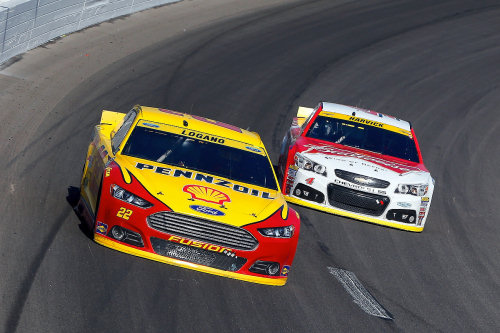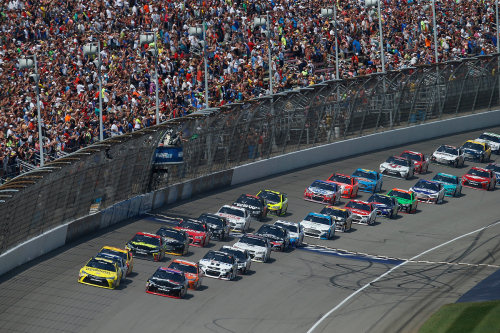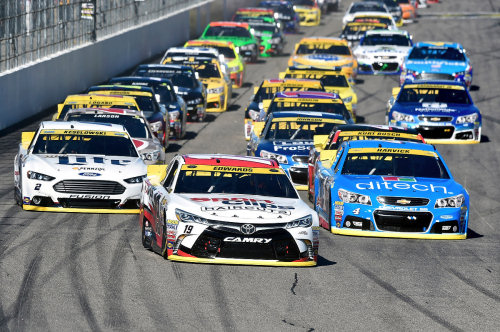The Way It Is/ Pumping up 'The Chase'by Gordon Kirby |
 Most everyone in NASCAR--drivers, team owners and media--are agog with excitement over 'The Chase'. From drivers' seats to scoring stands and media centers they rave on about the pressure and unpredictability of 'The Chase' and exclaim about what a great show it makes.
Most everyone in NASCAR--drivers, team owners and media--are agog with excitement over 'The Chase'. From drivers' seats to scoring stands and media centers they rave on about the pressure and unpredictability of 'The Chase' and exclaim about what a great show it makes.
And yet not only the crowds at many races but also NASCAR's TV ratings continue to glide steadily downhill to record low levels. I quote the following three paragraphs from last week's pre-Talladega Jayski.com TV ratings page. "Back on broadcast television for October 18th's Kansas race, NASCAR's Chase For the Cup had a modest improvement in the metered markets. NASCAR Sprint Cup racing from Kansas, the fifth race in the Chase For the Cup, drew a 2.2 overnight rating on NBC Sunday afternoon--up 10% from last year (2.0) and down a tick from 2013 (2.3), both of which aired on ESPN. The race drew a 2.6 overnight when it last aired on broadcast in 2009, and a 3.4 when it last aired on NBC in 2006. "The 2.2 is the lowest ever for a Chase For the Cup race on broadcast television, and the lowest for any Sprint Cup race on broadcast since at least 2004. In both cases, the previous mark was a 2.5 for the 2009 New Hampshire race on ABC. Every other race on broadcast this season has earned at least a 2.6 overnight.  © LAT USA Many people point to the Great Recession in 2008 as the beginning of NASCAR's decline but it's important to realize that the slide began eight years earlier at the turn of the century when NASCAR's most iconic superstar Dale Earnhardt was still with us. To put some perspective on this decline allow me to quote some words I wrote in 2000--15 years ago--in my annual review of the American racing season in Autocourse. "The first year of the new millennium was a very sobering one for American motor racing," I wrote. "After years of dizzy, immensely profitable growth, NASCAR suddenly faced a sudden decline in crowds and popularity. "NASCAR's problems came rapidly, almost unexpectedly, at the same time that Bill France Jr, boss of American stock car racing since 1972, found himself in a serious battle with cancer. France's father Bill Sr. founded NASCAR in 1949 and he and his son built it step by step into America's most business-like and formidable sanctioning body. But NASCAR's third generation leader Brian France has stepped into a very different world. "In recent years and last year in particular, attendance figures began to fall at many tracks. TV ratings have also declined and everything is being wagered to turn things around on a new $400 million contract with NBC, a network with little experience covering motor racing. "The fact is NASCAR is feeling the effects of too much growth. Too many tracks have been built with many more seats than most can fill. Steady increases in ticket prices have also driven away fans and because the France family's publicly-traded company ISC owns the majority of the tracks, the future looks challenging to say the least.  © LAT USA Since those days we've witnessed Earnhardt's death, the rise of new stars like Jimmie Johnson, Tony Stewart and Kevin Harvick, and the introduction of first the 'Car of Tomorrow' and then the latest 'Generation 6' car. Yet through all these changes the downward slide has continued. Recently NASCAR announced a new low downforce rules package for 2016. Rear spoilers will be cut from 6 inches to 3.5 inches while the leading edge of the splitter at the front of the car will be chopped from 2 inches to 0.25 of an inch and the radiator pan will be reduced from 38 inches to 33. Most drivers have lobbied for this low downforce package and a series of mass tests are scheduled at various tracks. Four-time champion Jeff Gordon is among those who are enthusiastic about the low downforce package. "I'm excited about the new low downforce package which is going to get us the type of racing that I really loved coming up through the ranks and over the years," Gordon says. "The cars used to be less affected by the aerodynamics but today aerodynamics plays a huge role. With the low downforce package I think you're going to see a lot more passing and some very exciting racing." Added Gordon: "NASCAR is still a phenomenal sport with a huge following all around the country. The product that's being put out on the track is fantastic." As regular readers know, I agree with Jeff about going to a lower downforce package. I've lobbied endlessly for less downforce and more horsepower in most forms of racing and many great drivers have also declared in this space that it's the only way to go.  © LAT USA But I think NASCAR as a whole is focused on the wrong issues and missing the big picture. First, the drivers have become marketing commodities rather than racing personalities, but in today's thoroughly commercialized world that's a difficult if not impossible thing to change. The days of tough guy, old lore legends like Earnhardt, Bobby Allison, Cale Yarborough, Curtis Turner, Fireball Roberts and Junior Johnson are long gone. As I wrote 15 years ago one of NASCAR's bigger problems is that it has too many races--too many long 500 mile races in particular. Yet this aspect is also impossible to change because none of the 23 tracks that stage the 36 Sprint Cup races have any interest in cutting back. Crowds may be down at many races but the Sprint Cup race weekend continues to be the biggest event and most important source of revenue by far for every track. Another element in the declining interest in NASCAR was the arrival of the CoT and Gen 6 spec cars. Time and again I've heard former NASCAR fans grumble that they no longer care because they can't cheer for their favorite brand. One of NASCAR's essential building blocks was the appeal of Ford vs Chevy vs Dodge but despite each brand of the Gen 6 car enjoying individual nose treatments the spec car has made the cars more identical than ever, reducing a key historical draw for many NASCAR fans. I also believe that at some point in the foggy future NASCAR will have to evolve away from their tube frames and 'stock block' V8 engines. But I have no idea how any such evolution could take place because the entire stock car industry in America is based on the current antique chassis and engines. Any attempt to move beyond today's package would result in a massive and costly disruption the likes of which NASCAR has never witnessed. The engine building business remains a core component of NASCAR and an example of the investment in existing infrastructure are the 136 people employed by Hendrick Motorsport in building more than 700 engines each year. Hendrick supplies no fewer than 19 teams in the Sprint Cup, Xfinity and Truck series. Fierce competition to develop the conventional single camshaft rocker arm V-8 NASCAR engine continues to blaze away among the likes of Hendrick, RCR, Roush/Yates and Toyota Racing Development. Some very smart guys work in the engine shops around North Carolina many of them coming up through the grass roots of American oval racing but quite a few of them relocating to the South from Formula 1, Indy car or sports car racing.  © LAT USA Eliminated from 'The Chase' after Talladega were Dale Earnhardt Jr., Matt Kenseth, Denny Hamlin and Ryan Newman. Kenseth has won five races this year and is third in laps led but will not be among those contending for the championship at Homestead-Miami on November 22nd. It would be silly if defending champion Harvick didn't make it to Homestead's final four. Harvick has won three races, finished second eleven times and led more than 2,000 laps, almost twice as many as anyone else. He's been the man to beat most of the year and by any normal standards is most deserving of this year's championship. If you want to measure who the year's most successful driver may be by prize money, Harvick led prior to Talladega with $7,920,921 earned so far this year. Logano was second with $7,477,480 in prize money. Third was Jimmie Johnson with $6.2 million followed by Kenseth with $5.6 million and Dale Jr. with $5.3 million in purse money. At this stage of the season no fewer than 31 Sprint Cup drivers have won $3 million or more. So despite those flagging TV numbers and other questions about the future, NASCAR remains in a league of its own as America's most professional and profitable form of motor racing. |
|
Auto Racing ~ Gordon Kirby
Copyright ~ All Rights Reserved |
